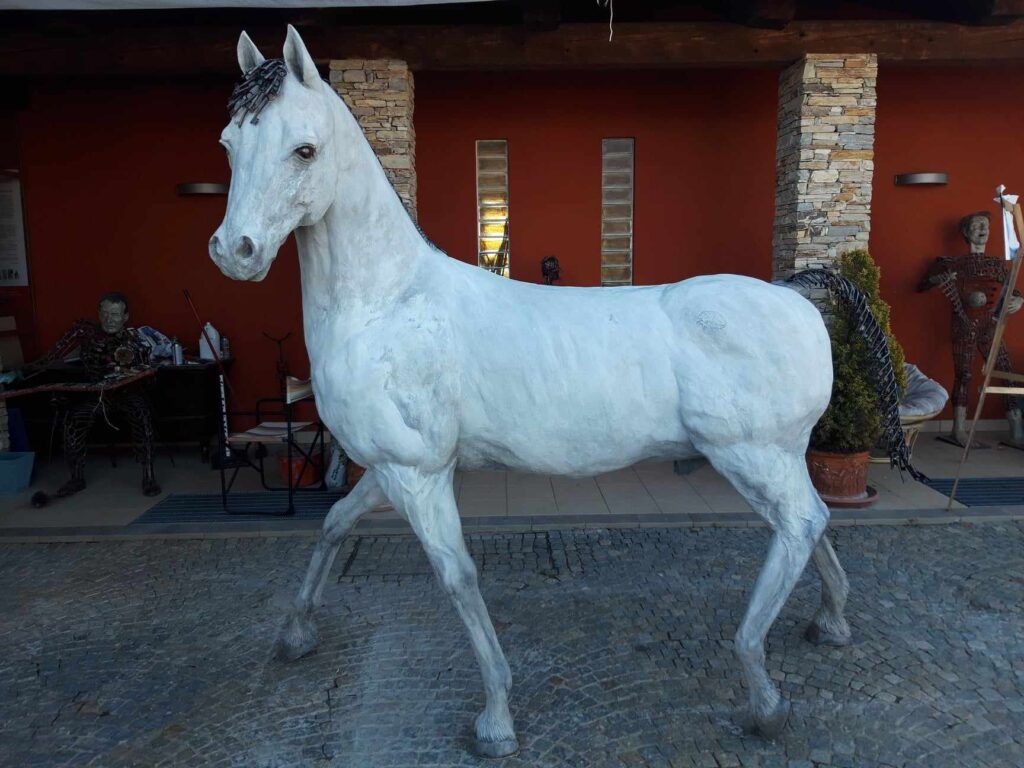The latest work by artist Franco Sebastiano Alessandria conveys a disarming power and, at the same time, vitality. By covering the iron structure with a special cement mortar, the author this time really amazes the public, shaping “Marengo”, Napoleon’s legendary horse, in life size. The splendid animal is depicted walking, with a proud, noble and austere air. The muscles and veins, darting under the skin. The back, slightly arched to the left, leaves the right side exposed. His gaze, severe and at the same time curious, comes from intense eyes. Nothing is left to chance. As observers, in the presence of him, we immediately had the temptation to reach out to caress him, held back only by the irrational fear that the animal could actually, at any moment, come to life. Unique “quirk”, which allows the viewer to detach themselves from reality for a moment; the mane and tail, recreated with ancient iron keys, the “trademark” of the works of Alessandria.
A “powerful” sculpture, with a certain impact, which also brings with it a story to tell, linked to the author’s childhood memories. Not easy years for him, which marked and “forged” him and which, in any case, led him to be what he is today.
Napoleon’s horse: a child’s dream come true
«At the age of three, I was taken to Cherasco, to the “Gallaman”, a boarding school for orphans, run by the kind Como nuns – says Alessandria -. We took a lot of walks; one of these led to the castle, where rows of centuries-old trees can still be seen today. In front of the castle, there was a large plane tree, with a large semi-broken branch, supported by a wooden support. . The nuns told us that Napoleon’s horse had been tied to that branch. The steed, by pulling and freaking out, had almost broken that big branch. And, as we know, children’s imagination flies and dreams. After more than half a century, Napoleon’s fairy tale and dream have come true in this white stallion.”
On Saturday 20 April, the horse will leave the artist’s home in Piozzo to reach Cherasco, where it will remain on display to the public. Just in time for the next weekend, that of 27 and 28 April, during which the city hosts a series of events and a large Napoleonic re-enactment in costume.

The story of “Marengo”: Napoleon’s favorite horse
“What color was Napoleon’s white horse?” As a child, each of us asked a friend at least once in our lives, for fun. But was Napoleon’s horse really white? Not really: Napoleon’s most famous horse was a light gray color – they explain on Geopop –. Of the many horses that Napoleon had, the most famous and loved was a small Arabian horse, named “Marengo”. The future emperor loved the animal: not too imposing, very agile, strong and resistant. “Marengo” belonged to this ancient and elegant breed. It was purchased by the French emperor during the Egyptian campaign against the Ottomans (1798-1801), and was described as docile, not very large and light gray in color. Its name was given to it following one of the most sensational victories of Napoleon’s military career, the battle of Marengo, near Alessandria, in Piedmont. Here, on 14 June 1800, one of the decisive clashes took place against the Austrians who, being defeated, had to cede much of northern Italy to Napoleon. The horse’s name is therefore associated with one of the most iconic military victories of the French leader. Together with his other steeds, Napoleon had “Marengo” at his side during all subsequent military campaigns, throughout Europe. The animal survived the disastrous retreat following the Russian campaign in 1812-1813 and also led its master during his last great battle, that of Waterloo on 18 June 1815. Following the defeat, Napoleon had to flee, abandoning Anglo-Dutch and Prussian forces, winners of the battle, his entire team. “Marengo” was captured by the British, who took him to England. Already quite advanced in years, the horse was kept to rest in various stables, where he mated and gave rise to a real offspring. He died in 1831, ten years after Napoleon. His skeleton is still kept at the National Army Museum in London.
Tags: Napoleons Horse latest impressive work Franco Alessandria





